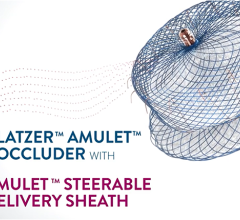
September 26, 2014 — AtriCure Inc. announced the introduction of the AtriClip Flex, a new device with a more flexible aluminum shaft that allows surgeons to better maneuver within a patient’s particular anatomy.
The device is one of four products within the AtriClip Left Atrial Appendage Exclusion System portfolio used in patients who suffer with atrial fibrillation (afib). The AtriClip Flex device is currently available in the United States, with availability in Europe and other geographies coming later this year.
The AtriClip is utilized by cardiac surgeons to occlude the left atrial appendage, a small muscular pouch attached to the left atrium of the heart. Since research indicates more than 90 percent of blood clots develop in the left atrial appendage management (LAAM) in afib patients [1], surgeons often exclude the appendage to prevent clot formation. AtriClip is the most widely used LAAM occlusion device with more than 35,000 sold worldwide since its introduction to the market in 2010.
“The introduction of the new AtriClip Flex with the malleable deployment tool shows AtriCure's commitment to constant improvement, to patients, and to the physicians who treat them on a daily basis,” said Theodore S. Wright, cardiothoracic surgeon at Gill Heart Institute, University of Kentucky HealthCare who was the first surgeon to use the AtriClip Flex device.
AtriClip has a U.S. Food and Drug Administration (FDA) indication for the occlusion of the LAAM under direct visualization, in conjunction with other open cardiac surgical procedures. The LAAM Exclusion System portfolio includes the AtriClip PRO, AtriClip long and AtriClip standard, which have different lengths and deployment features.
“AtriCure is dedicated to developing medical devices that solve complex problems and improve the lives of patients,” said Mike Carrel, chief executive officer of AtriCure. “AtriClip FLEX is a good example of how we listen and respond to the unique needs of surgeons.”
Patients who suffer from afib have a 500 percent greater risk of stroke, compared with the general population. [2] Afib-related strokes are associated with higher morbidity and mortality than non-afib related strokes. [3] More than 5.2 million people in the United States [4], and more than 33 million people worldwide [5], suffer with afib.
In early 2014, AtriCure initiated the Stroke Feasibility Study (NCT01997905) using the AtriClip System in a minimally invasive procedure on a beating heart. This study will evaluate the safety of the AtriClip System when used for stroke prevention in patients with non-valvular atrial fibrillation who can’t take long-term anticoagulation medications. Complete exclusion of the LAAM will be confirmed during the procedure using echo graphic imaging. The study will be conducted at seven hospitals in the United States, enrolling up to 30 patients.
For more information: www.atricure.com
References:
1. Jeff S. Healey, MD, Eugene Crystal, MD, Andrew Lamy, et al. “Left Atrial Appendage Occlusion Study (LAAOS): Results of a randomized controlled pilot study of left atrial appendage occlusion during coronary bypass surgery in patients at risk for stroke.” American Heart Journal. 2005 Aug; 150:288-93.
2. Benjamin EJ, Chen PS, Bild DE, et al. “Prevention of atrial fibrillation: report from a national heart, lung, and blood institute workshop.” Circulation. 2009 Feb 3; 119(4):606-18.
3. Marini C, De Santis F, Sacco S, et al. “Contribution of atrial fibrillation to incidence and outcome of ischemic stroke: results from a population-based study.” Stroke. 2005 Jun; 36 (6):1115-9.
4. Colilla S, Crow A, Petkun W, Singer DE, Simon T, Liu X, et al. “Estimates of current and future incidence and prevalence of atrial fibrillation in the U.S. adult population.” American Journal of Cardiology. 2013 Oct. 15; 112 (8):1142-7.
5. Chugh SS, Havmoeller R, Narayanan K, Singh D, Rienstra M, et al. “Worldwide epidemiology of atrial fibrillation: a Global Burden of Disease 2010 Study.” Circulation. 2014 Feb 25; 129 (8):837-47.


 March 31, 2025
March 31, 2025 







